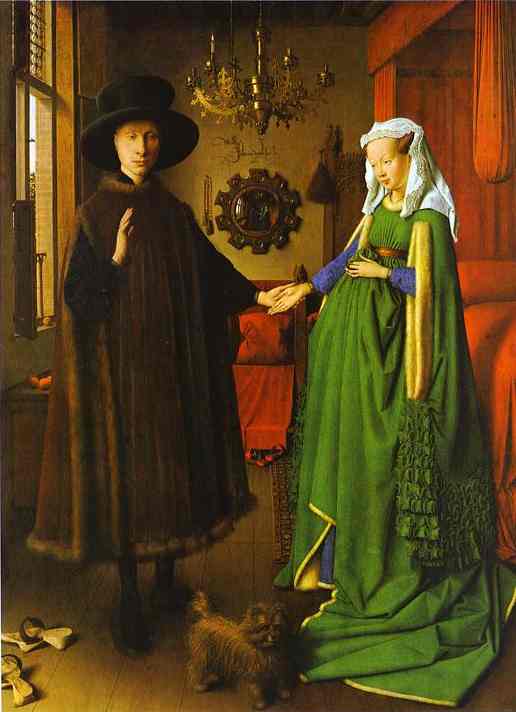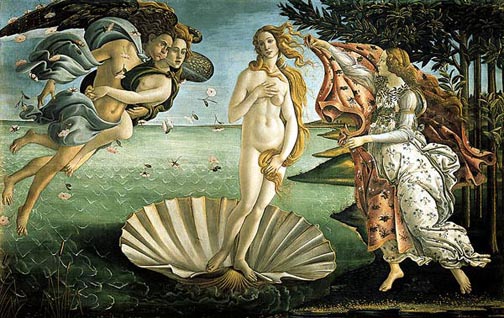Introduction
The way in which women have been depicted in paintings has changed dramatically over the years. Ancient artists in Rome and Greece depicted women in idealized form standing proudly nude in unabashed splendor. With the loss of these cultures, though, the female form was taken back into the private sphere, remaining hidden under voluminous clothing that prevented anything other than hands or face to be seen. Nevertheless, much could be discerned about the woman based on other elements that were often included in the details of the painting.
This type of approach can be seen in the work of painters such as Jan van Eyck, a Dutch painter working in the early 1400s. As the ancients were again turned to for inspiration with the advent of the Renaissance, women’s bodies were again released from their bindings and permitted to stride forward in full glory. This is seen in Sandro Botticelli’s painting, “The Birth of Venus” as he completely broke with the habits of tradition and permitted Venus her freedom. To illustrate this difference in approaches, van Eyck’s painting “Giovanni Arnolfini and His Wife” and Botticelli’s “The Birth of Venus” will be compared.
Main body
Jan van Eyck painted his “Giovanni Arnolfini and His Wife” in 1434. This painting has been largely acknowledged primarily due to the various examples of symbolism contained in the painting as well as for its unique perspective. However, left mostly out of the conversation is the idea that Arnolfini’s wife is pregnant. Closer inspection indicates that Jeanne de Chanany is not actually pregnant but is instead wearing the voluminous clothing popular for the early Renaissance period. “Although many modern viewers mistakenly assume Giovanna is pregnant, art historians familiar with 15th century painting point out the numerous amount of paintings of Saints in similar apparel and believe that an excessive amount of fabric was fashionable for women’s dresses at the time. (Hall, 1994. p. 105-6).
The bulge is explained by the extra gather of material she holds in her hand at her waist in imitation or exaggeration of pregnancy. It is argued that the bride’s apparent pregnancy was a means of indicating her willingness to bear children rather than an actual pregnancy. However, the lady’s stance, with one hand laid delicately, serenely and protectively upon a protruding stomach and slightly rounded shoulders as if bearing the additional weight of a child, at least provides every indication of pregnancy, making this an early portrait of pregnancy.

Van Eyck provides several clues to further suggest that de Chanany is pregnant. She is wearing a green dress as opposed to the traditional white, indicating this is not a virgin marriage, but instead one in full flower, full of life and ready to bloom. Green was also considered the color of hope, perhaps indicating that the woman hoped to have children for her new husband. The white of her hat is added to show the purity of the figure beneath it, assisted by the subtle visual resemblance to an angel’s halo. “On the bedpost is a tiny ornament of the statue of Saint Margaret, patron saint of childbirth” (“Arnolfini Portrait”, 2006).
In the depiction of her in van Eyck’s painting, Jeanne de Chanany is shown as a demure, obedient woman. Her eyes are downcast and focused upon her husband although he faces the viewer. She stands deep within the space of the room, sheltered near the large, canopied bed and protected from the window by Giovanni. Her hand lies open in her husband’s hand, palm up and accepting of whatever he would have her hold. Other than her face and hands, nothing can be determined with certainty regarding her figure and form, so hidden is she within the folds of her clothing. Rather than being focused on the concept of her pregnancy or hoped for pregnancy, the focus of this painting is upon the sanctity and aspirations of the marriage itself. Van Eyck’s signature appearing on the back wall above the mirror has given many art historians reason to believe he was among the witnesses for this wedding and the painting was created to commemorate it.
With the discovery of some of the classic art and architecture of Rome beginning in Italy in about 1300 but not reaching the rest of Europe for another few hundred years, there was renewed interest in the deities that had once been important to these people. Venus was reborn in statues and paintings throughout this period. Perhaps one of the most well-known of these resurrections is Botticelli’s “Birth of Venus.”

Although not the first image of Venus created during the Renaissance, Botticelli displays Venus in the nude, as she was in the classical poses, in such a way that she is made acceptable to his highly Christianized society in which the only nudes generally permitted were Adam, Eve or the crucified Christ figure. Her pose is not quite as natural as her various poses in Greek or Roman statuary as she is carried across the sea on a giant open clamshell that moves through the waves with the power of the wind, depicted as additional characters to the left of her.
The nudity in this painting provides various draperies to hide the more objectionable pubic regions while the women, Venus and the wind, are permitted to leave one breast exposed, emphasizing their nudity. For the first time in known history, Venus is provided with long, soft, flowing hair that is unrestrained as it moves on the wind. This flowing hair is necessary to cover Venus modestly until she finally reaches the shore where a woman awaits with appropriate clothing for her. The message here is that supernatural creatures are permitted their nudity, but before they are able to join the rest of society, they must be dressed appropriately. Venus’ attempts to cover her breasts serve only to bring attention to them by leading the eye to that region of the painting. She has alabaster skin reminiscent of the ancient statuary from which her inspiration came and a cool, reserved approachability in her facial expression as well as a slender, slightly muscular build easily seen.
Conclusion
Botticelli’s depiction of Venus is vastly different from the depiction of women provided by van Eyck. While Jeanne de Chanany is required to cover almost every inch of her body in clothing that is too bulky to permit even the slightest hint regarding her true form to be determined, Venus is given almost nothing to cover herself should she desire to do so. Jeanne de Chanany is protective and submissive in her stance, quiet and demure as she awaits her husband’s directives while Venus is almost careless in her attempts to cover herself. Her gaze meets the gaze of her viewers fearlessly and her attitude is one of command rather than one of submission. While both images depict a sense of intimacy, van Eyck’s of the intimacy of the solemn moment and the pledge being taken and Botticelli’s nude plus the intertwined figures of the winds, the type of intimacy is different.
Van Eyck’s painting gives a sense of cold duty, reinforced by the excessive clothing, the submissive woman and the space that serves to separate the two married people in this most intimate moment. Botticelli’s, on the other hand, gives a sense of instant association and acceptance, the viewer is automatically a part of the scene but is kept back by the note of command visible in Venus’ face. The twined images of the winds strike a highly intimate pose within themselves, yet this effort is completely confined to bringing Venus to her destination rather than from any interest in each other. As a result, both paintings illustrate the dual nature of woman – her intimacy and her distance, her exposure and her mystery.
Works Cited
- “Arnolfini Portrait, The.” Wikipedia, The Free Encyclopedia (2006).
- Witcombe, Christopher L.C.E. “Women in Prehistory.” (2008). Web.
- Hall, Edwin. The Arnolfini Bethrothal. CA: University of California Press, (1994): p. 105-6.